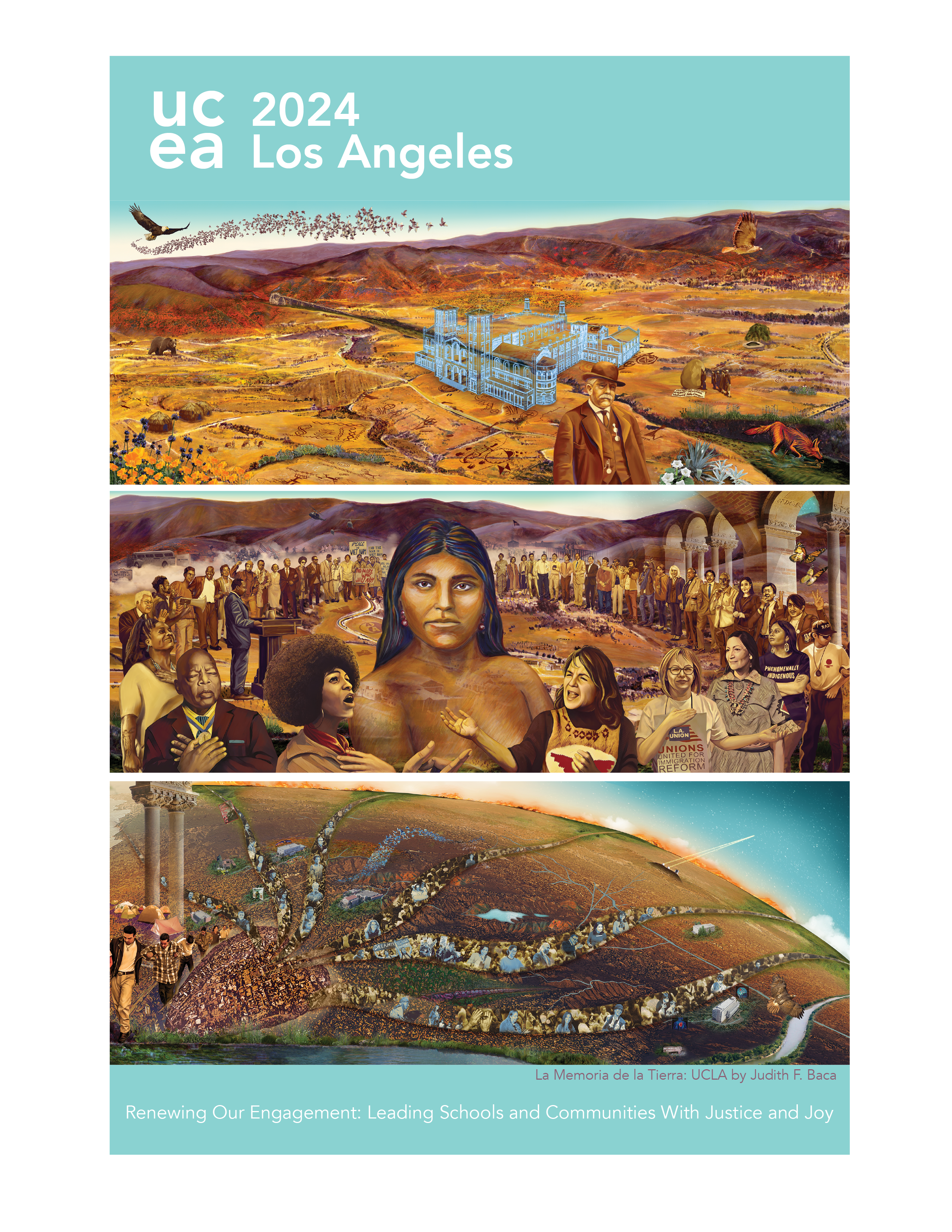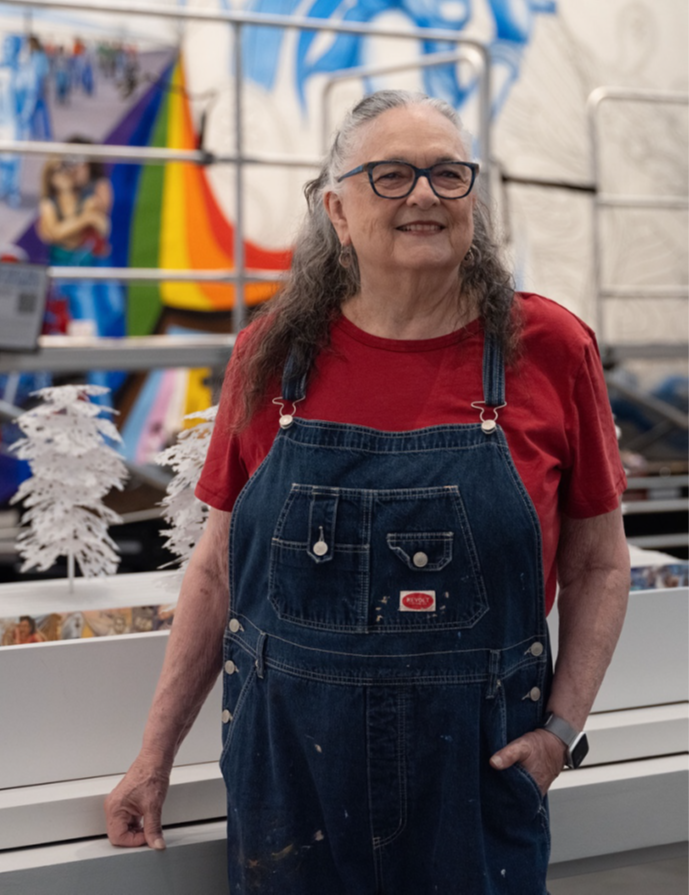Convention Artwork
Convention Artwork
UCEA is honored to have permission from Judith F. Baca, recipient of the National Medal of Arts, to have her 2021 mural panels for our Convention artwork. According to her National Endowment for the Arts bio, Dr. Baca turns "forgotten histories into public memory—pioneering an art form that empowers communities to reclaim public space with dignity and pride." Learn more about La Memoria de la Tierra: UCLA/The Memory of Earth/UCLA and the artist below.

Description
Judith F. Baca2022, La Memoria de la Tierra: UCLA
Each panel of the three-panel digital mural measures approximately 119" (height) by 307" (length), 10' by 26' long glass panels. Image courtesy of the SPARC Archives SPARCinLA.org.
My public artworks are about the memory of the land. This mural is a piece of land in memory, including Westwood’s original people and the land and rivers original state. The story of Westwood flows over the three, 26-foot long panels; starting off is a tribute to the land, detailing where the Los Angeles River had once flowed and where the Gabrielino/Tongva tribes and native flora and fauna thrived. The second segment, homage is paid to many men and women who have impacted UCLA and its Bruin community, leading into an imaginative depiction of the future in which the university is ever-changing and in harmony with the original land." – Judy Baca
FROM ARTICLE: https://newsroom.ucla.edu/stories/judy-baca-mural-unveiled
The middle panel is built around a trinity of women: Toypurina, a Tongva woman who opposed the colonial rule by Spanish missionaries in California in the late 1700s; Angela Davis, civil rights activist and former UCLA faculty member, who was fired by the University of California Board of Regents for her association with communism; and Dolores Huerta, the iconic labor leader who worked with César Chávez on behalf of farmworkers. - Mike Fricano, April 4, 2022, UCLA Newsroom. New mural captures campus history and UCLA’s future Renowned artist and professor Judith Baca created the nearly 80-foot artwork.
The nearly 80-foot mural is on the north side of Ackerman Union as part of the Wescom Student Terrace.
The mural, which translates into English as The Memory of Earth: UCLA, is made up of three 26-foot-long glass panels. The left panel portrays Westwood — long before UCLA — with a shimmering light-blue outline of Royce Hall where it sits today. In the center, a circle of dozens of people including faculty, alumni, civil rights and social justice leaders whom Baca called her heroes and said represent the diverse and lesser-known history of campus and the land.
The middle panel is built around a trinity of women: Toypurina, a Tongva woman who opposed the colonial rule by Spanish missionaries in California in the late 1700s; Angela Davis, civil rights activist and former UCLA faculty member, who was fired by the University of California Board of Regents for her association with communism; and Dolores Huerta, the iconic labor leader who worked with César Chávez on behalf of farmworkers.
We hope in the future that students will be able to sit here [in this courtyard] and be able to find out who these people are and what did they do, said Baca, who retired last year, after years as a professor of Chicana and Chicano and Central American studies and a professor of world arts and cultures.
To situate the people in their proper historical context, the mural captures scenes from events such as the Black Lives Matter student demonstrations in 2020, protests against the Vietnam War in 1976 and also a depiction of the Manzanar War Relocation Center.
The future of the campus is on the right, with rhizomes (long, narrow channel-like roots) filled with the faces of other significant people — many of them faculty — who are doing the work to bring UCLA into the future and ensuring that UCLA remains in harmony with the land.
Baca told the audience that the third panel was designed to take the knowledge that comes from the university and [spread] it widely.
The mural is the result of a partnership among the UCLA Centennial Committee; Associated Students UCLA, or ASUCLA, a nonprofit association that drives student services and activities throughout campus; and the Digital Mural Lab from the Social and Public Art Resource Center, or SPARC. It was in 1976 that Baca and two other artists founded SPARC, a Venice-based arts center that creates, preserves and hosts programs about community-based public artwork. The mural was created with financial support from Wescom Credit Union.

Artist, Educator, Scholar/Activist, Community Arts Pioneer, UCLA Professor Emeritus and Founder of the Social and Public Art Resource Center (SPARC)
I want to produce artwork that is beautiful and inspirational, and beyond decorative. I excavate public spaces to hear public voice, and to create public consciousness about the presence of people who are often the majority of the population but are not represented in a visual way. By telling their stories I hope to give voice to those least heard and to visualize a more whole American story. I call this creating sites of public memory.
Judy Baca painting the Great Wall 1960’s at LACMA, 2024
BIOGRAPHY
Dr. Judith F. Baca, American visual artist, has dedicated over four decades to creating impactful public art. Her murals bring art into the daily lives of communities. In 1974, she established Los Angeles' first mural program, producing over 400 murals, offering employment to thousands and evolving into the Social and Public Art Resource Center (SPARC). She serves as SPARC's artistic director, focusing on digital technology to advocate social justice and participatory public arts projects through the UCLA@SPARC Digital/Mural Lab.
Baca’s public art monuments reflect the interconnectedness of history, people, and place, emphasizing diverse struggles for rights and community ties to the memory of land. Her most renowned work is the ongoing Great Wall of Los Angeles since 1974, a half-mile mural in San Fernando Valley that has engaged hundreds of youth and their families, artists, oral historians, and scholars.
Now Professor Emeritus at the University of California, Los Angeles, where Baca was a senior professor in Chicana/o Studies and World Art and Cultures Departments. In 2012, the Los Angeles Unified School District named a school after her called the Judith F. Baca Arts Academy, located in Watts, California, her birthplace. Baca's contributions have earned her prestigious accolades, including the Guggenheim Fellowship and United States Artist Rockefeller Fellowship. She has also received numerous awards most notably, the 2021 National Medal of Arts, the highest presidential honor awarded to artists in the United States